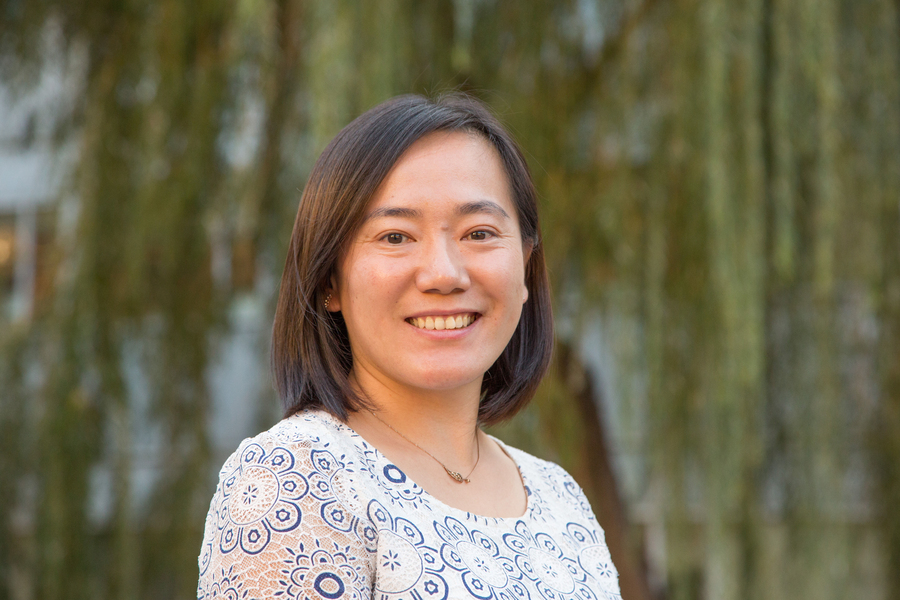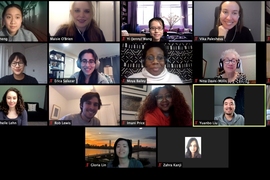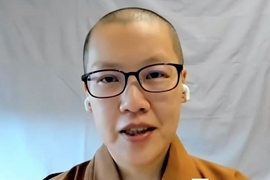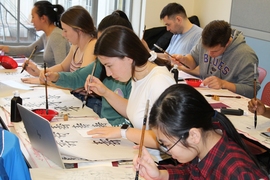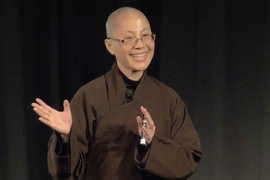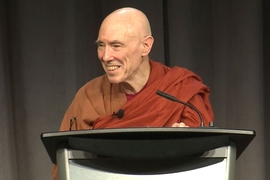With the onset of the Covid-19 pandemic, student well-being has become a pressing issue for many instructors. In this interview, Panpan Gao and Kang Zhou, lecturers in Chinese at MIT Global Languages, discuss their project to produce original meditation videos tailored for Chinese language learners. Working with a team of collaborators, they launched their website Meditation for Chinese Learners. The team has just received funding from MIT’s MindHandHeart Community Innovation Fund to further expand the project for the coming academic year.
Q: What was the inspiration for this project?
Panpan Gao: I had the idea even before the pandemic began, but after Covid-19 hit, I saw the stress everyone was under. I noticed in class that some students seemed to have a huge emotional burden, but they wouldn’t talk about it during class. This made me think whether it is possible to create a “third space” through a second language, for the students to combine language learning with pressure relief, so learning a second language is not adding more pressure, but rather helping them deal with existing pressures.
Q: What is the connection between language learning and meditation?
Kang Zhou: It’s important for us as language teachers to create an immersive language environment for our students. At MIT, we strive to provide our students with various opportunities outside of the classroom to use the language and interact with Chinese culture. The meditation project serves both purposes, and it is so accessible to the students. They can be in their dorms, on our campus, by the Charles [River], or at home. As long as they start the video, they can enter a colorful Chinese learning world with rich culture embedded. We tell our students to just relax, enjoy, and let learning happen naturally.
Gao: Meditation has become popular in recent years, and there are more and more meditation materials in various languages. But this project is the first attempt, to our knowledge, to combine meditation and Chinese language learning. The scripts are tailored for different proficiency levels so even beginners can start to enjoy meditation in Chinese. In addition to improving language skills, this project helps students to appreciate the beauty of the language by feeling its rhythm. The project also shows the possibility of using a different voice — a foreign language — to relax, to think, to heal, and find inner peace.
Zhou: Teachers can sometimes overlook the anxiety students experience. Learning a language is very challenging. What we are trying to explore is to help the learners decrease their level of anxiety through meditation as we immerse them in the second language, so they can face their study, and their lives in general with a healthier and more positive attitude.
Gao: We are living in a time of information explosion, and meditation is like a “pause button” in our fast-paced lives. It allows us to slow down, take a look at ourselves, and find peace. This helps us get along with people around us, and with ourselves. For me, as a native Mandarin speaker, meditation in English is a unique experience. Using a second language can sometimes bring you into a completely different “thought bubble.” It will also strengthen your sense of safety and belonging to the second language and culture.
Q: Was it especially difficult to write for a beginner-level student?
Gao: We needed to restrict the vocabulary and grammar structures for the beginners, but at the same time, we wanted the language to be natural and authentic. It is not easy to find a balance. We tried to embed emotions and viewpoints in simple language, in order to create a powerful context that provides room for imagination. For instance, in “Fun in the Snow,” which can be used right after learning phrases about time, we created a scene inside of a warm cafe on a mountain covered in snow, and the script goes: “We sat there, looking at the snow for one minute, two minutes, 10 minutes, 20 minutes ...” Using very limited words, we are able to guide our beginner-level listeners to experience “living in the moment.” Another example is color. In “A Horse on the Grassland” we are trying to convey the idea of diversity and inclusion by saying: “You can be a red horse, or a black one, or a white one. No matter what you are, you are free.”
Q: What was the reaction of students to the materials?
Zhou: I started using these meditation materials in my Chinese class this spring. When students appeared to be tired or under a lot of pressure, we would use the last five minutes for meditation. From my own observation and their feedback, they truly enjoyed the process. I hope that all my students can walk out of my class with inner peace and a healthy attitude that can help them handle the pressure at school and even outside of MIT, in their own lives. A student told me that meditation sometimes helps them sleep. I am glad that to learn this, because at MIT, students need good sleep.
Gao: We have a script for advanced-level students called “A Ride on a Time Machine” where we describe a scene at a traditional Chinese house, with the grandpa drinking tea in the yard with his little grandson sleeping in his arms. Details are added — like the Chinese characters on the front door, the tea set on the table, the grandpa wiping off the child’s sweat — so listeners can tour around the house and experience the happy life of a big family. After listening to the recording, one student said, “I saw the expansive blue sky in the yard and it made me feel really peaceful.” Another said, “I feel that I am part of the picture, as if I were the sleeping kid, and it was my grandma who was holding me. It made me feel warm and safe.” I feel that the mediation is like a cultural trip in which students deepened their understanding and appreciation of Chinese families and found inner peace at the same time.
Q: Panpan, I understand you initiated the project, but the materials are produced by a team of collaborators. How does the team work?
Gao: I am mainly in charge of coming up with themes and writing the scripts. After I draft a script, the whole team will read it and make adjustments to make the sentences more natural or to make sure that the script is at the adequate difficulty level. Kang is in charge of the voice work. After Kang finishes recording, the whole team will listen to it and share ideas on editing, such as what background music to use or what sound effects to add at a certain point. Zixian Peng is our “sound engineer,” which is great because he has both language-teaching experience and audio-editing expertise. He’s currently a graduate student in Beijing, and he used to teach Chinese at Williams College and Middlebury Chinese School. He is mainly in charge of reducing noise, eliminating verbal flubs, and adding sound effects, as well as background music. Yanting Li, who previously taught at MIT, is our media manager. Yanting Li works at Northwestern University as a Chinese lecturer.
Q: Kang, how is the voice work important for the meditation videos?
Zhou: When I’m reading the scripts, I hope to send peace, warmth, and care to the listeners. They need to see the inner side of themselves and find their own pace of breathing, so my role is a “guide.” I hope that through good use of my voice, we can guide our listeners into the time and space created in the script. Then they can forget about me and focus on communicating with themselves, and eventually, find their true selves.
Q: Is the project ongoing?
Gao: We publish a new video every week. We are working on the third theme “Animals” now and begin the next theme “Spring” in May.
Q: Can you leave us with an excerpt from one of your scripts?
Gao: Sure. This is the English translation of a few lines from “A Horse on the Grassland,” a beginner meditation script:
Now you are not you anymore. You are a horse, a horse on the prairie, a free horse on the prairie.
You are running happily and freely on the green grassland.
You may be tall or short.
You may be very young, or you may be old.
You may be a red horse, or a black one, or a white one
Whatever you are, you are free.
